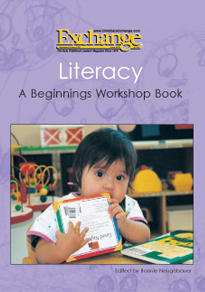ExchangeEveryDay Past Issues
 << Previous Issue
| View Past Issues | | Next Issue >>
<< Previous Issue
| View Past Issues | | Next Issue >> The Pause that Teaches
September 30, 2011
Raise your sail one foot and you get ten feet of wind.
-Chinese proverb
-Chinese proverb
 The Beginnings Workshop Book on Literacy contains insightful articles on creating readers, children's conversations, multi-language programs, bilingual education, storytelling and much more.
The Beginnings Workshop Book on Literacy contains insightful articles on creating readers, children's conversations, multi-language programs, bilingual education, storytelling and much more.
ExchangeEveryDay
Delivered five days a week containing news, success stories, solutions, trend reports, and much more.
What is ExchangeEveryDay?
ExchangeEveryDay is the official electronic newsletter for Exchange Press. It is delivered five days a week containing news stories, success stories, solutions, trend reports, and much more.
Only $6.00 per order and 50% profit on every sale. Your bank account will start Greening up!
Large 15 Gal Commercial Container. Hands-Free “Step & Drop” Disposal. Clean Hygienic Enclosed System. Preferred by University Child Care.




Comments (1)
Displaying 1 CommentFitchburg State College
Leominster, MA, United States
"Uhs" and "ums" that fill pauses when adults speak to toddlers, may actually aid the toddlers in expanding their vocabularies" may be a semi-tarry event, it isn't silence and yet allows the child an opportunity to make sense of whatever happened. I coined Tarry Time for my dissertation and it has evolved for the practitioner.
Tarry Time: A term coined by Diana Suskind,(1979), to represent a child’s opportunity from birth to take self-regulated time and space to mindfully consider a situation before responding and taking action. This opportunity is provided by the non-intrusive observant adult who is quietly available for guidance if needed. It is amount of silence between interactions. Technically: "the time between one end point in speech and the next beginning point in speech expressed as the percentage of silent time during the observation."
Tashira Gilletta who is a Lead Educarer at Liberty Children's Home in Ladyville, Belize wrote:
I would say my favorite tarry time is bath time because you develop that bond and trust with the child. I could go so far as to say when you are dealing with the child nude (not in a bad way but we all know that’s private being like that), when you are with a child you would like them to feel safe and secure with you. Even when you’re in a bath, all different types of conversation come up; you’ll be surprised -- like what happened in school, etc. from a little bump on a hand or foot. They can also learn their body parts. You feel the warmth and trust from the child. Personally another tarry time for me I do enjoy would be reading a story. Twins would start talking about the picture they see. They will get all excited. Communication is the key. You don’t quite understand them but yet they like to talk or express themselves. To be honest they are coming along pretty well from health to strength. (Strength is learning)
Post a Comment